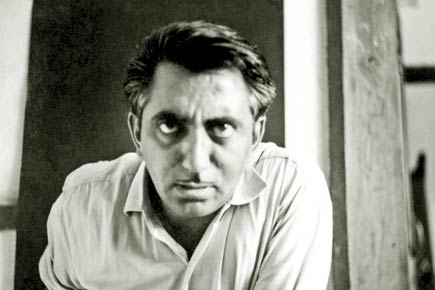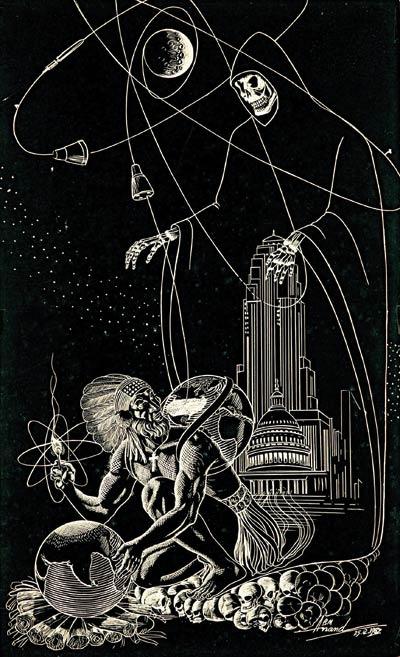Thirty years after his death, artist Brij Mohan Anand’s off-centre works get due recognition with a new monograph

Brij Mohan Anand
 There is a striking anecdote from artist Brij Mohan Anand’s (1928-1986) life that writer-biographer Aditi Anand calls to mind. It was December 1972, when Anand — deeply affected by the ravages of the ongoing war in Vietnam — decided to make his dissent public. The artist setup a printing press unit at home and involved his family and friends in an unusual errand. His A-team was tasked with sending out greeting cards made from his scratchboard composition 'Stop Burning Asia (The Death (sic) is Shadowing You)' to embassies, consulates and newspapers across Delhi.
There is a striking anecdote from artist Brij Mohan Anand’s (1928-1986) life that writer-biographer Aditi Anand calls to mind. It was December 1972, when Anand — deeply affected by the ravages of the ongoing war in Vietnam — decided to make his dissent public. The artist setup a printing press unit at home and involved his family and friends in an unusual errand. His A-team was tasked with sending out greeting cards made from his scratchboard composition 'Stop Burning Asia (The Death (sic) is Shadowing You)' to embassies, consulates and newspapers across Delhi.
ADVERTISEMENT

Opposed to the idea of commoditising art, Brij Mohan Anand (1928-1986) never exhibited any of his work
This was one of the rare occasions when the ‘reluctant artist’ put his foot down, and broke his own code of not showing his artworks at galleries, says Aditi, 42, who is a lawyer by profession, but switched to writing with Anand’s book.
Thirty years after his death, the self-taught Amritsar-born Modernist's vast body of work is finally getting its due with a monograph titled ‘Narratives for Indian Modernity: The Aesthetic of Brij Mohan Anand’. Co-authored by Aditi and British art historian Dr Grant Pooke, the book was unveiled on May 12 at an exhibition — curated by art scholar Dr Alka Pande — at the India International Centre (IIC) in Delhi.

Anand’s scratchboard Stop Burning Asia (The Death (sic) is Shadowing You) was a critique of the Cold War
“One of the most distinctive features of this artist was that he had a social conscience. He believed that art needed to be a source of social and political commentary,” says Aditi, who started working on the book in early 2012 after the BM Anand Foundation approached her.

Authors Aditi Anand and Dr Grant Pooke
She got Pooke, who was then teaching at the India Habitat Centre, and specialises in art history of the Cold War period, to help contextualise Anand’s work. Pook’s association with the book shed light on the Left-leaning artist’s anti-imperialist sentiments during the Cold War period. Consider Anand’s iconography, symbolism and text, such as those in Stop Burning Asia… — here, Western imperialism is represented as a figure of death rising over a native American Indian, symbolic of the tragic fate of the victims of war. “His critique of the scratchboards and the landscape speak of a subaltern view of India’s emergence into modernity. I was struck by its originality,” says Dr Pooke, who is a senior lecturer of art history at the University of Kent.
“Anand was a superb draughtsman and this is visible in the fluency of his lines. One can see that he has also indirectly assimilated bits from Soviet realist and constructivist art. And to think that he didn’t have any formal training!”
The book is the result of a four-year-long research on the maverick artist’s life and critically analyses some of his works, which comprise a gamut of brilliant artistry, including scratchboards, nude sketches, ink drawings, oil on canvas, book covers among others.
The research, however, was very challenging, says Aditi because Anand was not a public figure. “Until now, his works were completely unknown,” insists Aditi. “Anand earned a living by being a commercial illustrator, and was sought after by many publishers. But he reserved his art only for himself. Since he felt very strongly about art not being commoditised, he never made any attempt to exhibit or sell his works during his lifetime,” she adds. Anand died at the age of 58 due to cardiovascular complications.
With hardly any information available on him in the public domain, the authors had to rely on interviews with friends and family, peers, and corroborate their stories to help paint a robust picture. “He is a lost voice of Indian modernity and a man way ahead of his time. Through this book and the exhibition, we hope to preserve Anand’s story.”
 Subscribe today by clicking the link and stay updated with the latest news!" Click here!
Subscribe today by clicking the link and stay updated with the latest news!" Click here!






